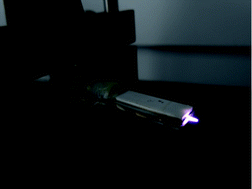Performance evaluation of a newly designed DC microplasma for direct organic compound detection through molecular emission spectrometry
Abstract
A low-power, portable dc microplasma source has been developed for use in molecular emission

* Corresponding authors
a
Research Center of Analytical Instrumentation, Analytical Testing Center, College of Chemistry, Sichuan University, Chengdu, China
E-mail:
yduan@scu.edu.cn
Fax: +86 28 85418180
Tel: +86 28 85418180
A low-power, portable dc microplasma source has been developed for use in molecular emission

 Please wait while we load your content...
Something went wrong. Try again?
Please wait while we load your content...
Something went wrong. Try again?
X. Yuan, X. Ding, Z. Zhao, X. Zhan and Y. Duan, J. Anal. At. Spectrom., 2012, 27, 2094 DOI: 10.1039/C2JA30246B
To request permission to reproduce material from this article, please go to the Copyright Clearance Center request page.
If you are an author contributing to an RSC publication, you do not need to request permission provided correct acknowledgement is given.
If you are the author of this article, you do not need to request permission to reproduce figures and diagrams provided correct acknowledgement is given. If you want to reproduce the whole article in a third-party publication (excluding your thesis/dissertation for which permission is not required) please go to the Copyright Clearance Center request page.
Read more about how to correctly acknowledge RSC content.
 Fetching data from CrossRef.
Fetching data from CrossRef.
This may take some time to load.
Loading related content
